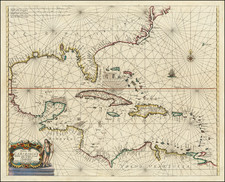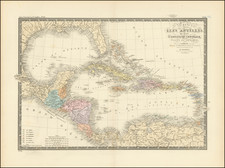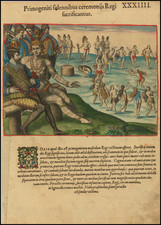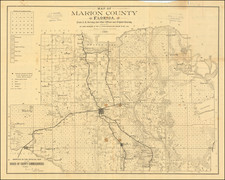Fine image of an early Native American settlement surrounded by a wooden palisade, based upon original watercolor paintings by Jacques Le Moynes de Morgues, an official French artist, who accompanied two important French Expeditions to North America in the 1560s.
The text describes how the natives build their fortified towns by building palisades around them. Sentries who are adept at smelling the enemy are stationed in small huts full of slits and holes by the entrance. When they detect enemies, they shriek and chase after them.
Taken from the publication of the reports of Jean Ribault (1562) and Rene Goulaine de Laudonniere (1564) expeditions, entitled Brevis narratio eorum quae in Florida Americœ provincia Gallis acciderunt . . .
On the first French voyage to the province of Florida, the crew, led by Captain Jean Ribaut, landed at a promontory surrounded by densely wooded and extremely tall trees. In honor of France, the captain of the fleet named it Cape François, and noted its position as about 30° North from the equator. Following the coast north from there, they found a wide and pleasant river at whose mouth they dropped anchor, so that next day they might explore more closely.
The map on the left shows the French discoveries along the coast of South Carolina, made several days after the sighting of what was originally named Cape Francois, but which on the second voyage under Laudonniere would be called the River of Dolphins (Fluvius Delfinum).
Theodor de Bry (1528-1598) was a prominent Flemish engraver and publisher best known for his engravings of the New World. Born in Liege, de Bry hailed from the portion of Flanders then controlled by Spain. The de Brys were a family of jewelers and engravers, and young Theodor was trained in those artisanal trades.
As a Lutheran, however, his life and livelihood were threatened when the Spanish Inquisition cracked down on non-Catholics. De Bry was banished and his goods seized in 1570. He fled to Strasbourg, where he studied under the Huguenot engraver Etienne Delaune. He also traveled to Antwerp, London, and Frankfurt, where he settled with his family.
In 1590, de Bry began to publish his Les Grands Voyages, which would eventually stretch to thirty volumes released by de Bry and his two sons. The volumes contained not only important engraved images of the New World, the first many had seen of the geographic novelties, but also several important maps. He also published a collection focused on India Orientalis. Les Grands Voyages was published in German, Latin, French, and English, extending de Bry’s fame and his view of the New World.

![[St. Augustine, Florida] Oppidorum apud Floridenses structura. XXX By Theodor De Bry](https://storage.googleapis.com/raremaps/img/small/98035.jpg)








![Memoir on the Geography, and Natural History and Civil History of Florida, attended by a Map of that Country, Connected with the Adjacent Places: and an Appendix, Containing the Treaty of Cession, and other Papers Relative to the Subject [with:] Map of Florida](https://storage.googleapis.com/raremaps/img/small/81777.jpg)




![County Map of Florida [with inset of Mobile]](https://storage.googleapis.com/raremaps/img/small/71379.jpg)